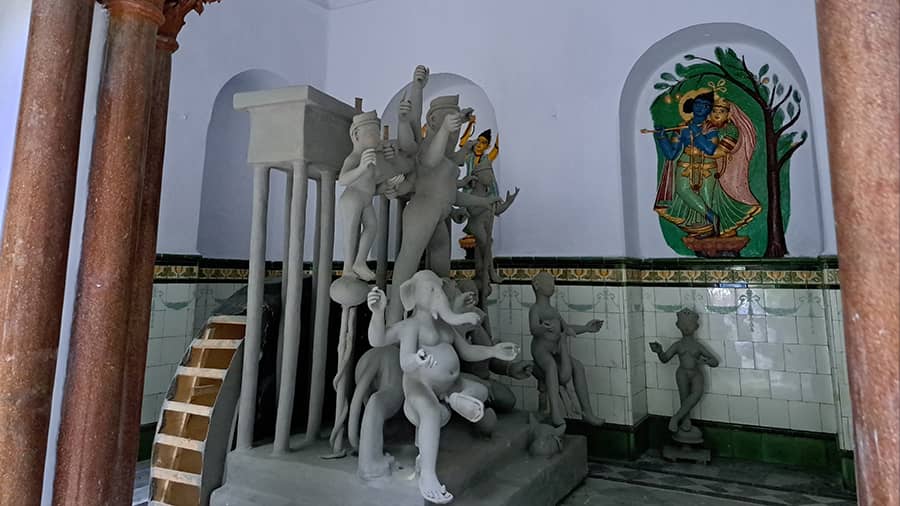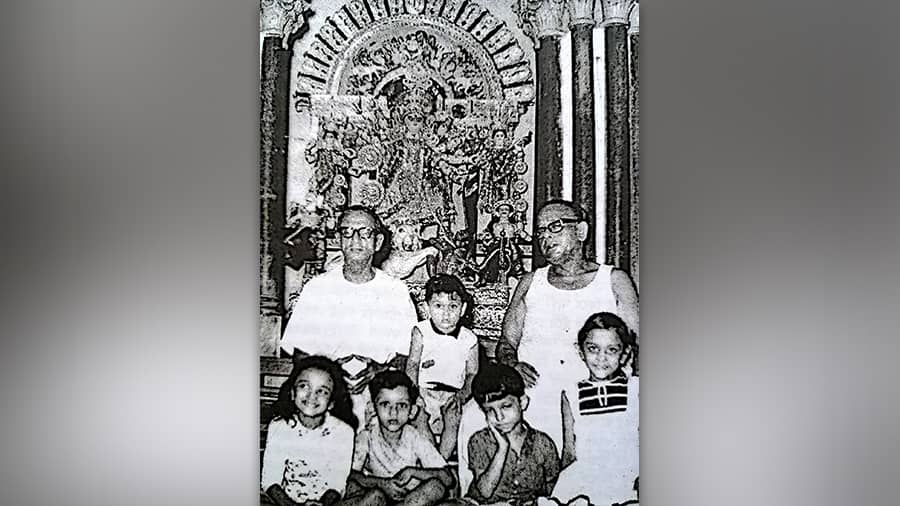The Sen family’s massive mansion, off Amherst Street, is a sight to behold. Located near the B.B. Ganguly Street crossing, the Sen residence, built in 1909, stands like a silent sentinel of Calcutta’s colonial past. It is in this house that an almost century-old Durga Puja is still arranged every year.

The Sen family residence, located near the B.B. Ganguly Street crossing
The Sens were one of the richest families during the British era. Interestingly, the family, originally residents of Saptagram in Hooghly, are related to Gouri Sen, the popular figure widely known for his kindness and generosity to people in need. An ancestor of the Sen family, Bholanath Sen, had settled in Calcutta’s Kolutola area and made an enormous fortune by selling horse feed to the Calcutta Corporation race course.
The business reached its height under the leadership of his son, Sambhoonath Sen, who started exporting horse feed to countries like Burma, Malay, Ceylon, Japan and the Philippines. At the same time, thanks to his connections and business acumen, he became the distributor for Lever Brothers, Jacob biscuits, Horlicks and P&G. As a trader, he amassed so much wealth that by the 1930s, the family owned more than 35 houses in Calcutta. The piece of land on which the School of Tropical Medicine now stands on Central Avenue, was also once owned by them.
Taking over the Puja
By this time, in 1926, Sambhoonath came to know that one of his relatives, residing on Braj Gopal Dutta lane, was about to discontinue their family puja due to financial troubles. Sen gladly took over the puja and started it at his own house. Thus began the Sen family puja in Bowbazar in 1926. He also installed the idol of Radha Govinda Jiu, their family deity, in an adjacent house. Here, funded by the trust he set up in 1944, festivals like Akshay Tritiya, Janmashtami, Dol Yatra and Ras Utsav are regularly celebrated. This same trust also allocates funds for Durga Puja.
Rajkumar Sen, now 86, is the grandson of Sambhoonath Sen and he fondly recalls the rich tradition of their family puja since the early 1940s.

Rajkumar Sen, the doyen of the Sen family
Although he doesn’t remember much of his grandfather, he does recall that Sambhoonath, even after starting Durga Puja in his own abode, never used to come close to the Durga mandap during the five days of Puja. The real reason behind this isn’t really known, but it is believed, and Rajkumar Sen thinks so too, that it was because of Sambhoonath’s daughter, who had become a widow at the age of 11. He used to carry the burden of this pain even during Durga Puja, and would only go near the idol when the ritual of kanakanjali was being carried out on the day of immersion.
Unique rule for couples
Sambhoonath’s daughter, who had returned to her father’s home after becoming a widow, was alive till 1965 and unlike her father, used to lead the puja arrangements with other married women of the family. The Sen family has a unique rule — a newly married couple can participate in the puja only after taking diksha within the first year of their marriage. This rule is still abided by all.
The Sen family puja follows the Vaishnav rituals of worship, and thus, no non-vegetarian food is offered to the goddess. Also, the family has never had animal sacrifices in the history of puja. The idol is made right on the Durga dalan of the house. In the past, sculptor Mani Pal was in charge of idol-making for the family. His third generation will be making the idol this year.

Idol-making in progress at the Sen residence
On the day of Sashthi, the idol is decked up with golden ornaments and on Saptami, the elders of the family join the ritual of nabapatrika’s Ganga bath. These are all family traditions that the Sens still follow meticulously. Earlier, on the day of Navami, the Sen family would be visited by European and Anglo-Indian gentlemen, all heads of the companies Sambhoonath was associated with. Rajkumar Sen recalls that they used to relish Bengali delicacies like luchi and alur dum with other guests.
The idol worshipped by the family is known as sarbasundari Durga, which is quite a rare form in Bengal. Goddess Durga and her five children are installed on a pedestal, which is placed between 12 clay pillars, six on each side. Although the gods and goddesses are put on the same platform, they are all built as separate idols and a big chalchitra acts as the backdrop for all. This is a unique form of idol-making and that is the way it has been since 1926.
No ‘sindoor khela’
Every year, family members from all branches of the family come together for the puja. Grand feasts and merrymaking continue till Dashami. Unlike many other family pujas, the women of the Sen family do not have the ritual of sindoor khela, but they do offer vermillion to Goddess Durga before bidding her adieu.
Many members of the family used to spend nights at the family mansion in the old days. Now, however, thanks to the crowds and hullabaloo at the adjacent Santosh Mitra Square puja, most avoid staying the night. Even so, Rajkumar Sen expects 500 guests this year.

The Sen family’s Durga idol in the late 1960s
The Sen family Durga Puja will be celebrating its centenary soon, and the family hasn’t missed arranging for the annual festivities for even a single year. Rajkumar Sen considers it a matter of great pride. “Even during the 1943 famine and 1946 Great Calcutta Killings, our puja was held,” he said.
The one thing that worries him is that with each passing year, the number of participants in the puja is decreasing, and the younger generation of the family is not too involved in the festivities. But Rajkumar Sen is a practical man and is aware that times are changing. In spite of what the future holds, as a doyen of the Sen family, Rajkumar Sen is proud of the fact that his family is still carrying forward the tradition his grandfather started many years ago.


